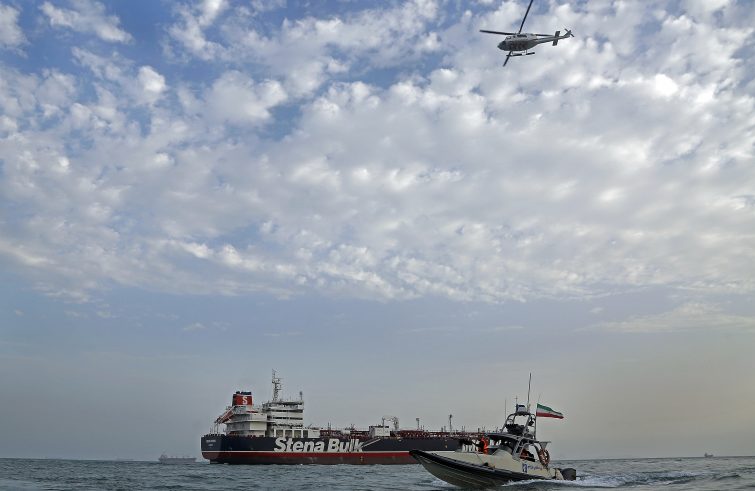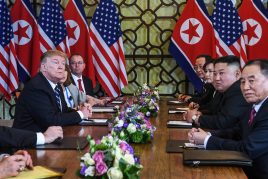
The height of tension was reached last June 20 when US President Donald Trump called off a military attack on Iran in retaliation for the shooting down of a US drone. A different decision would have sparked off a serious escalation in the Persian Gulf where tensions between the US and Iran started to mount three months ago. On May 12, attacks damaged four oil tankers near the Strait of Hormuz. The US believes that Iran was responsible for the attacks. On May 14, drones of the Yemeni Houthi rebels, allies of Iran and enemies of Saudi Arabia and the United Arab Emirates, hit Saudi oil pumping stations. The tension rose again in June with an attack on two oil tankers in the Gulf of Oman: this time Trump openly accused the Pasdaran, Iran’s Islamic Revolutionary Guard Corps (IRGC). The latest developments occurred in July: first Iran tried to stop a British oil tanker passing through the Strait of Hormuz, while shortly after the UK seized an oil tanker off Gibraltar suspected of carrying Iranian oil despite the embargo. The Iranian response was not long in coming: on 19 July IRGC seized a British tanker passing through the Strait.
“What is happening in Hormuz is the predictable escalation of the US exit from the Iran nuclear deal of May 8 2018”,  Matteo Bressan, International relations professor at LUMSA University, member of the Scientific Board of Nato Defence College Foundation, told SIR. The deal signed in July 2015 between Iran and the so-called P5+1 (United Kingdom, France, USA, Russia, China and Germany), envisaged the reduction of Iran’s nuclear facilities while international economic sanctions imposed on the Islamic country would be lifted. “The Deal supported by Barack Obama was opposed by Trump – the Professor pointed out – who vowed maximum pressure on Iran, thereby targeting the leaders of the regime, especially the Supreme Leader and the Pasdaran – that played an ever greater economic role in the reconstruction and entrepreneurial activity in the country since the end of the war against Iraq in the ’80s- labelled a ‘terror group’ by the US. The Deal was strongly opposed also by Israel and Saudi Arabia. The two countries argued that the agreement granted Iran a role of regional player, thereby paving the way to the conflicts in Yemen and Syria.”
Matteo Bressan, International relations professor at LUMSA University, member of the Scientific Board of Nato Defence College Foundation, told SIR. The deal signed in July 2015 between Iran and the so-called P5+1 (United Kingdom, France, USA, Russia, China and Germany), envisaged the reduction of Iran’s nuclear facilities while international economic sanctions imposed on the Islamic country would be lifted. “The Deal supported by Barack Obama was opposed by Trump – the Professor pointed out – who vowed maximum pressure on Iran, thereby targeting the leaders of the regime, especially the Supreme Leader and the Pasdaran – that played an ever greater economic role in the reconstruction and entrepreneurial activity in the country since the end of the war against Iraq in the ’80s- labelled a ‘terror group’ by the US. The Deal was strongly opposed also by Israel and Saudi Arabia. The two countries argued that the agreement granted Iran a role of regional player, thereby paving the way to the conflicts in Yemen and Syria.”
 Is there a possibility of negotiating a new agreement?
Is there a possibility of negotiating a new agreement?
The Hormuz crisis could represent a final escalation before negotiating a new deal. Trump has always called Barack Obama’s deal as the ‘worst possible ever’. In his live announcement of withdrawing from the Deal, the President made it clear that he was leaving a door open to dialogue. The impression is that he would like to replicate with Iran the pattern adopted with North Korea, alternating threats and insults with the possibility of encounter and dialogue. Events such as those that occurred in the Persian Gulf over the past few weeks would probably have sparked off a potential conflict some time ago. Today
I think there are signs of a new negotiation
And it won’t be a carbon copy of the 2015 Deal. In order to negotiate a new agreement on nuclear proliferation with the United States, Iran will have to comply with 12 requests, illustrated at the end of May by the US Secretary of State, Mike Pompeo. These are diktats demanding the cessation of support to Middle Eastern groups defined as “terrorists” (e.g. Hezbollah, Hamas, Islamic Jihad, ed.’s note) to the same IRGC, and to all hybrid, political and military activity, which they carry out abroad. These issues fall outside the scope of nuclear program control and aim to contain Iranian influence in the region.
Pompeo has also requested to curb its ballistic missile program and thus the development of nuclear weapons…
Control of the Iranian ballistic missile program is another issue which is now being discussed again and which was not resolved in the 2015 agreement. The Iranians say they build them for defence purposes, but as has been pointed out, no ballistic missile construction is planned unless nuclear warheads are mounted on them.
The challenge is to reach an agreement that incorporates reassurances for Israel and Saudi Arabia and at the same time allows Iran to return on the international stage without being kept isolated: it would be a big mistake, comparable to not being able to control the nuclear program. It would also be a mistake to send fleets to escort oil tankers with the risk of causing an incident.
Europe is trying to safeguard the P5+1 deal. Has it succeeded?
It is objectively difficult for Europe to safeguard the 2015 agreement. International order is shaped around American hegemony. It’s hard for Europe alone to maintain an agreement whereby financial transactions and Iranian oil exports are frozen. Whoever tries will be punished. They could have tried with Russia and China.
Do you believe that the “maximum pressure” strategy will be successful?
I’m not very optimistic. I hope this strategy will bring the concerned parties around the negotiating table. But without a plan B, it could prove dangerous. It won’t be easy for Iran to accept a new deal based on Mike Pompeo’s diktats, not without the deep suffering it has been experiencing for the past year. Sanctions have an impact on the population and the economy alike. The more negotiations drag on, the more difficult the situation becomes.
The Nuclear Deal is a starting point to address a broader issue: whether or not to reinstate Iran on the international stage. I wonder how successful it would be to isolate Iran as a rogue State.











